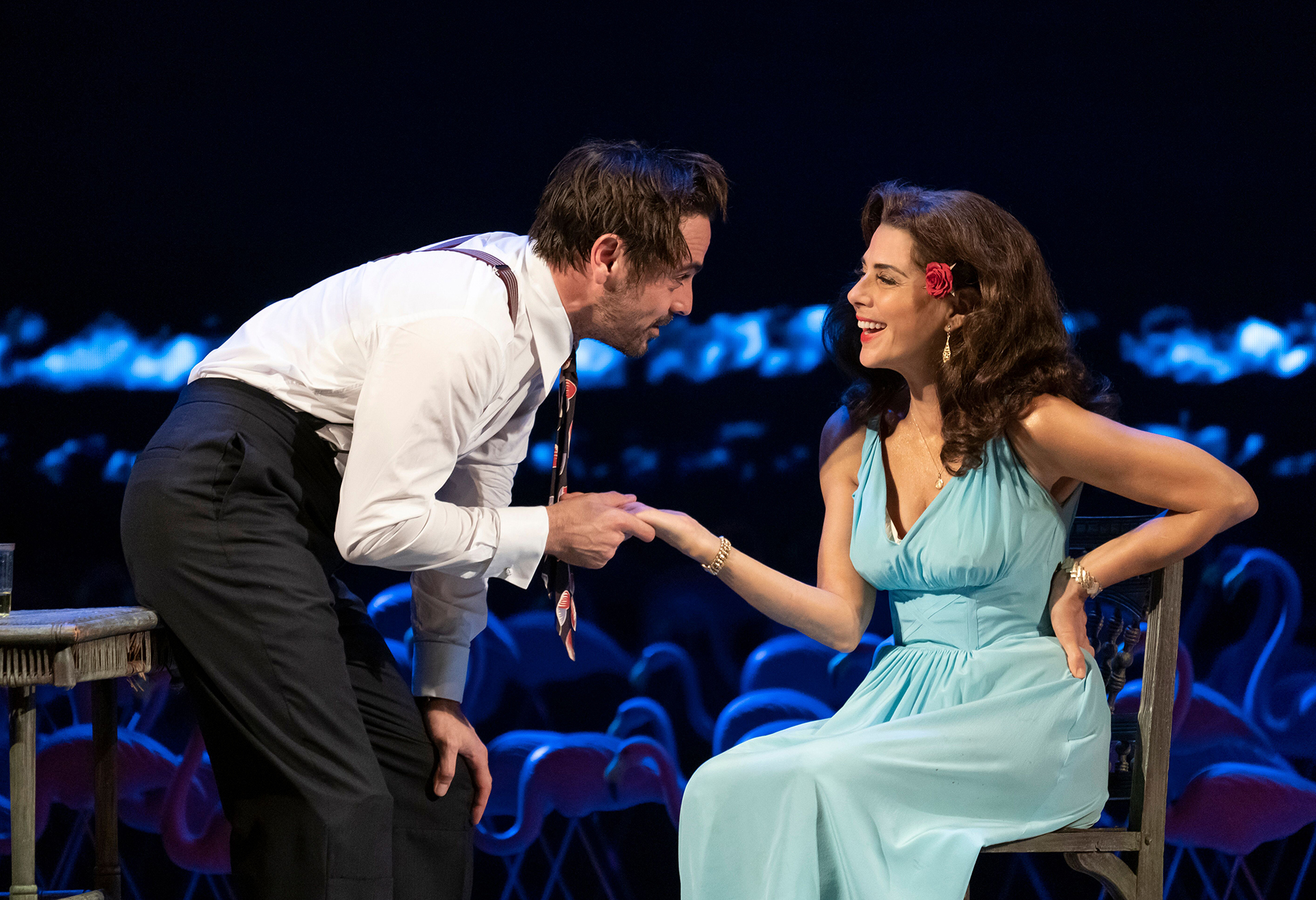‘The Rose Tattoo’ Has Cinematic Sweep

Do you remember the final scene of “La Dolce Vita,” after the monster fish appears, with the men gathering the fishnet, kids playing on the beach, and Marcello Mastroianni moving away, enigmatically? It’s arousing to watch, and it fills our senses.
Seeing Trip Cullman’s production of “The Rose Tattoo” at the Roundabout Theatre brings to mind such classic cinematic imagery. Here, immigrant Sicilians spill onto the sand of the Louisiana Gulf Coast town where the play takes place. For me, it evokes Fellini’s imagery — a primal force washed ashore. In Tennessee Williams’s play, this is a joyous discovery.
While it’s one of Williams’s lesser known works, the 1955 movie is remembered for Anna Magnani’s emotionally powerful, Academy Award-winning portrayal. In more comic mode, Marisa Tomei gives us a passionate, sensual, and sexy Serafina Delle Rose. Bearing a remarkable likeness to Elizabeth Taylor in the roles she portrayed in the 1950s and ‘60s, Tomei reaches into the depth of her character with physical abandon exuding sexiness.
When she spreads her hands open, reaching out her arms, claiming her womanliness, and her heritage, saying, “Sicilian,” it’s as if the sun were bursting out of her. She’s equally raw at the death of her husband, and at betrayal. Flinging herself into a heap, digging her heels into the sand, or physically shunning her suitor, Tomei is an eyeful to watch.
When Alvaro, a somewhat grisly-looking, unshaven rogue arrives, he too prods our collective memory, evoking the great clowns of the silent movies. That role, portrayed with aplomb by Emun Elliott, marks a promising Broadway debut.
That director Cullman’s approach flourishes in film imagery is in keeping with the dramatic structure of Williams’s play. His most light -hearted work, “Tattoo” combines comedy, tragedy, and classical Greek drama. References to Dionysus abound. Also, in this production, a chorus of Sicilian women sing incomprehensibly with melancholic sensuality. Jason Michael Webb’s music is incredibly beautiful.
Most outstanding, the scenic elements (Mark Wendland) contribute largely to the cinematic sweep of the production. Projected footage (Lucy Mackinnon) of the ocean tides meet the onstage sand in an enigmatic metaphor. Humanity set against the illusion of life — the movie set — brings a joyful redemption.
Children playing, townspeople going about their business, Sicilian ladies pining in song, all contribute to the ongoing life of the play. The town gossips, entertainingly played by Paige Gilbert and Portia clad (by costume designer Clint Ramos) in bright red and yellow contrast with the Sicilian ladies in their black dresses of mourning. And the sea, beautifully lit by Ben Stanton, is the ever-changing mural that carries through their lives.
The Sound Inside
There is something ineffable about our favorite actors, something present and pervasive, yet untouchable. Such an actor is Mary Louise Parker, whose portrayal of a creative writing professor in Adam Rapp’s new play, “The Sound Inside,” is daunting.
Parker, who blends toughness with frailty, brings to mind the film icon, Katharine Hepburn. Her tall, lithe frame, and long, slender fingers construct a picture of gracefulness. And her ability to appear familiar, approachable, and sublime all at once make her work on stage, and in film highly memorable.
Indeed, Parker is the perfect heroine for Adam Rapp’s drama. As Bella (Parker) expresses it in her opening monologue, “She often dissuades her students from describing a protagonist in too fine of detail . . . If you do your authorial job correctly, your reader will create the rest of the character.” The same applies to the Hollywood shaman on whom we project our own conscious and self-conscious thoughts.
Here, in Rapp’s two-person drama, Parker is on stage throughout most of the play, struggling with writer’s block, her cancer diagnosis, and her relationship with a particular student. Although Rapp’s predisposition to small spaces, and East Village settings is absent here, his preoccupation with depression, drugs, suicide, and a generalized sense of depravity is very much alive. So is his poetic writing style.
As is his wont, director David Cromer reaches into the humanity and despair of these two characters with great aplomb. Here the student, Christopher Dunn, deftly portrayed by Will Hochman in his Broadway debut, is a character we’ve met before in Rapp’s plays. A disillusioned artistic young man, whose existential quest pulls him into irresolvable dimensions.
Much like the character, Raskolnikov, in Dostoyevsky’s “Crime and Punishment,” which Bella teaches in her class, Christopher is proud and haughty, albeit gloomy and morose. More important, he embodies Raskolnikov’s dualities, and contradictory actions. His foreshadowing observation early in the play, “The notion of counterbalancing a carefully plotted murder with good deeds is fascinating stuff” speaks to a major contradiction indeed.
His intimacy with Bella develops through their conversations about the stories they write, stories which clearly parallel the play’s narrative. Cromer explores the drama of their emotional interplay beyond the literal events of the plot. In fact, very little happens here, in the sense of action. Similarly, it’s staged in an open space with little adornment.
After all, Bella’s idea of heightened experience is finding a partner who she can lie in bed with, reading a great novel. “Because loving a book,” she opines, “is kind of like having an affair, after all.” And Bella does love Christopher’s novel. That novel is the beginning and the end of their life together.
In its way a trifle, “The Sound Inside” is evocative of the Golden Age of Broadway shows, a pleasure of the moment that captures a sense of character, and zeitgeist in tumultuous times.



